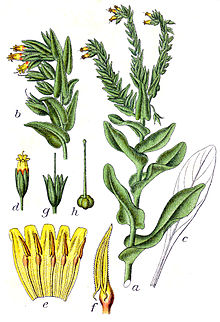Bald wax flower
| Bald wax flower | ||||||||||||
|---|---|---|---|---|---|---|---|---|---|---|---|---|

Bald wax flower ( Cerinthe glabra ) |
||||||||||||
| Systematics | ||||||||||||
|
||||||||||||
| Scientific name | ||||||||||||
| Cerinthe glabra | ||||||||||||
| Mill. |
The bald wax flower ( Cerinthe glabra ), also known as the Alpine wax flower , is a species of wax flower ( Cerinthe ) in the family of the predatory plants (Boraginaceae).
description
Vegetative characteristics
The bald wax flower is an almost completely bare, perennial herbaceous plant that reaches heights of 15 to 60 centimeters. The lower leaves are stalked, wedge-shaped, without spots, the upper stems encompassing and ovoid.
Generative characteristics
The flowering period is between May and July. The zymous inflorescence is nodding.
The hermaphrodite flowers are five-fold with a double flower envelope . The calyx tips are blunt, glabrous or have few bristle hairs. The corolla is 8 to 14 millimeters long, mostly yellow, partly blue on the outside and mostly with five dark red spots on the inside. The corolla lobes are blunt, short and turned outwards.
The partial fruits are about 4 millimeters long, dark brown and shiny.
The number of chromosomes is 2n = 18.
ecology
The pollinators are mostly bumblebees .
Occurrence
The alpine wax flower is a European-Southwest Asian mountain plant. It occurs in Europe in the Pyrenees , Alps , Jura , Corsica , Abruzzo , Carpathians and in the mountains of the Balkan Peninsula , but is absent in Greece. It can also be found washed down from the mountains, for example in Baden-Württemberg in the Illertal.
The alpine wax flower thrives in Central Europe on fresh, nutrient-rich, mostly calcareous, mild, humus-rich, often stony loam or clay soils or rubble soils . It grows in unkrautigen Staudenfluren the sub- alpine belt and cattle warehouses. It is a character species of the Rumicion alpinae association, but also occurs in plant communities of the Adenstylion or Aegopodion associations. It rises in the Alps to an altitude of 2250 meters.
Nature conservation in Germany
The Alpine wax flower in Germany is threatened with extinction in some areas, for example in Baden-Württemberg. According to Erhard Dörr, stocks there have declined sharply since 1970. It occurred here in so-called “Illergries”, an alluvial forest-like area with remains of dry meadows. There is a threat, for example, from afforestation.
Systematics
The first publication of Cerinthe glabra was in 1768 by Philip Miller with the name in The Gardeners Dictionary , 8th edition: Cerinthe no.2.
Some authors have about two subspecies:
- Cerinthe glabra subsp. glabra (Syn .: Cerinthe alpina Schult. , Cerinthe pyrenaica Arv. tour. , Cerinthe glabra subsp. caucasica Hadač , Cerinthe glabra subsp. pirinica (Stoj. & Eight.) N.Andreev & Peev , Cerinthe glabra subsp. tatrica Hadač and Cerinthe glabra var. pirinica . Stoj. & night )
- Cerinthe glabra subsp. smithiae (A.Kern.) Domac (Syn .: Cerinthe smithiae A.Kern. ): This endemic occurs only in Croatia.
use
The bald wax flower was previously used as an ornamental and medicinal plant.
Individual evidence
- ↑ a b c d e f g A. Kleinsteuber: Boraginaceae. In: Oskar Sebald, Siegmund Seybold, Georg Philippi, Arno Wörz (eds.): The fern and flowering plants of Baden-Württemberg . tape 5 : Special part (Spermatophyta, subclass Asteridae): Buddlejaceae to Caprifoliaceae . Eugen Ulmer, Stuttgart (Hohenheim) 1996, ISBN 3-8001-3342-3 , pp. 86-88 .
- ↑ Cerinthe glabra at Tropicos.org. In: IPCN Chromosome Reports . Missouri Botanical Garden, St. Louis
- ↑ a b Erich Oberdorfer : Plant-sociological excursion flora for Germany and neighboring areas . With the collaboration of Angelika Schwabe and Theo Müller. 8th, heavily revised and expanded edition. Eugen Ulmer, Stuttgart (Hohenheim) 2001, ISBN 3-8001-3131-5 , pp. 783 .
- ↑ a b c d Benito Valdés, 2011: Boraginaceae. Datasheet Cerinthe major In: Euro + Med Plantbase - the information resource for Euro-Mediterranean plant diversity.
- ↑ Cerinthe glabra at Tropicos.org. Missouri Botanical Garden, St. Louis, accessed July 25, 2020.
Web links
- Thomas Meyer, Michael Hassler: Mediterranean and Alpine flora. Data sheet with photos.


